Best National Parks for Kids and Seniors
Becky Hart | Feb 28, 2024
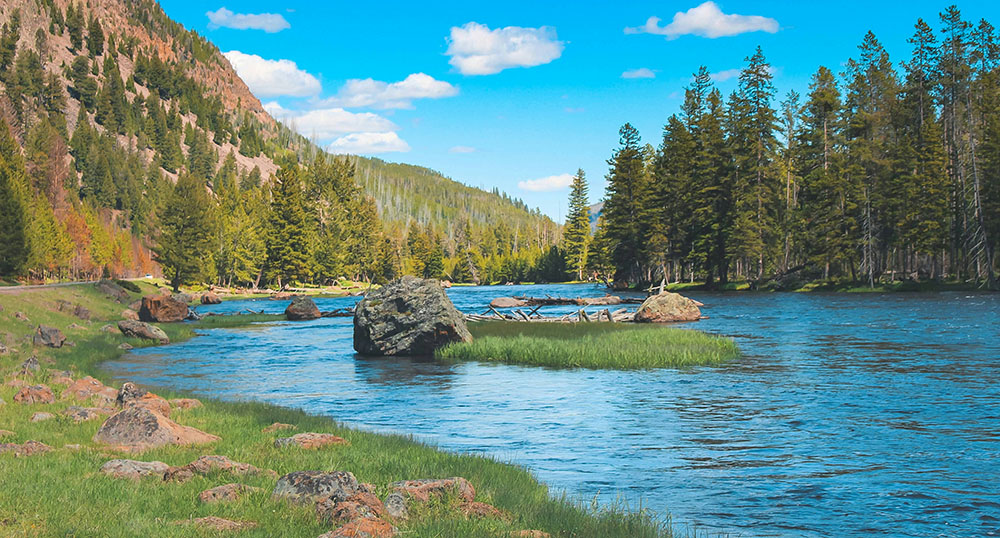
Wide-open spaces, room to breathe, the chance to roam and see Mother Nature at her finest. This is why U.S. national parks are popular destinations for family vacations.
Not all parks are the same, though (which is part of what makes them so amazing, if you ask us). Here’s where you’ll find the best national parks for kids and everyone else in the family.
How to Choose the Best National Parks in the USA
With such stunning diversity in U.S. parks, you’ll want to match your family’s wish list with the right destination.
1. Factor in ease of access.
Some national parks are in remote areas, while others are closer to cities. If you think you’ll lose your mind if you hear “Are we there yet?” one more time, look for parks that are easier — and quicker — to reach. Some of these include Rocky Mountain National Park, which is not far from Denver, and Great Smoky Mountains National Park, which is a short drive from tourist-friendly cities in Tennessee.
Consider the ease of getting around inside the park, too. Some sites can be seen more easily from your car than others, which is ideal if you have mobility challenges, don’t want to drag the kids out in the rain, or simply need a break between hikes. Remember that some parks will also offer shuttle buses, most of which are wheelchair-accessible.
2. Match the terrain to your family’s age and ability.
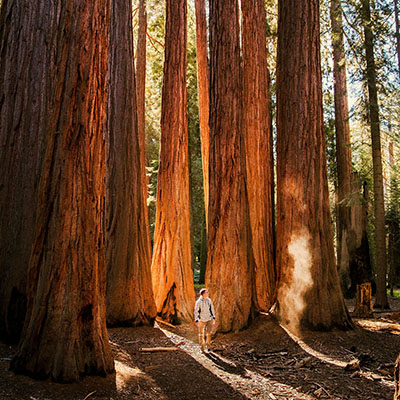 Hiking is one of the highlights of getting out in nature. But if you’re traveling with someone with short legs (hello, toddlers) or mobility challenges, you probably want a park with a selection of flat terrain or paved trails. This is a big reason you’ll find parks like the Everglades on the list below.
Hiking is one of the highlights of getting out in nature. But if you’re traveling with someone with short legs (hello, toddlers) or mobility challenges, you probably want a park with a selection of flat terrain or paved trails. This is a big reason you’ll find parks like the Everglades on the list below.
3. Look for family-friendly activities.
Savvy parents and caregivers know that one of the secrets to traveling with kids is planning something to keep them occupied and engaged. Some parks do better than others when it comes to offering programs and activities to capture kids’ interest.
The NPS Junior Range program encourages kids to complete a series of activities during their visit. They’ll then earn their very own Junior Ranger patch or badge. Also look at the parks’ list of ranger-led programs. Some are adapted specifically for the younger crowd with hands-on demonstrations.
4. Consider the accommodations.
Picnicking is a great way to save money while you travel. And since you’re already at a park, dining al fresco with epic views can feel extra special. With that in mind, look for parks with the best picnic facilities with benches, tables, and drinkable water.
If you’ll be in the park for longer than a day or picnicking isn’t your cup of tea, look for parks with restaurants and other food options that fit your tastes and budget. Expect to pay more at these restaurants than you would outside the park.
Finally, keep public restroom availability in mind. These can vary from quite nice in visitor centers and lodges, to more primitive pit toilets at campgrounds and on trails, to downright non-existent.
5. Keep it budget friendly.
Vacationing as a family can get expensive, but there are ways to travel on a budget. When it comes to national parks, weigh the cost of single admission versus annual passes. If you plan on visiting multiple parks, a national park annual pass likely will save you money.
You can also get senior annual and lifetime passes if you’re 62 or older. Active-duty members of the U.S. military and veterans, individuals with disabilities, and fourth graders (unexpectedly specific, we know) can get free passes.
The U.S. National Park Service also hosts free admission days several times each year, typically in conjunction with a holiday. These are usually Martin Luther King, Jr. Day; the first day of National Park Week, celebrated in April; the anniversary of the Great American Outdoors Act, which is in August; National Public Lands Day in September; and Veterans Day.
And if you love free — who doesn’t? — some parks don’t charge entrance fees. Head for New River Gorge National Park and Preserve in West Virginia, which was just upgraded to national park status in 2021, or Redwood National and State Parks in northern California, for example. More on the Redwood parks below.
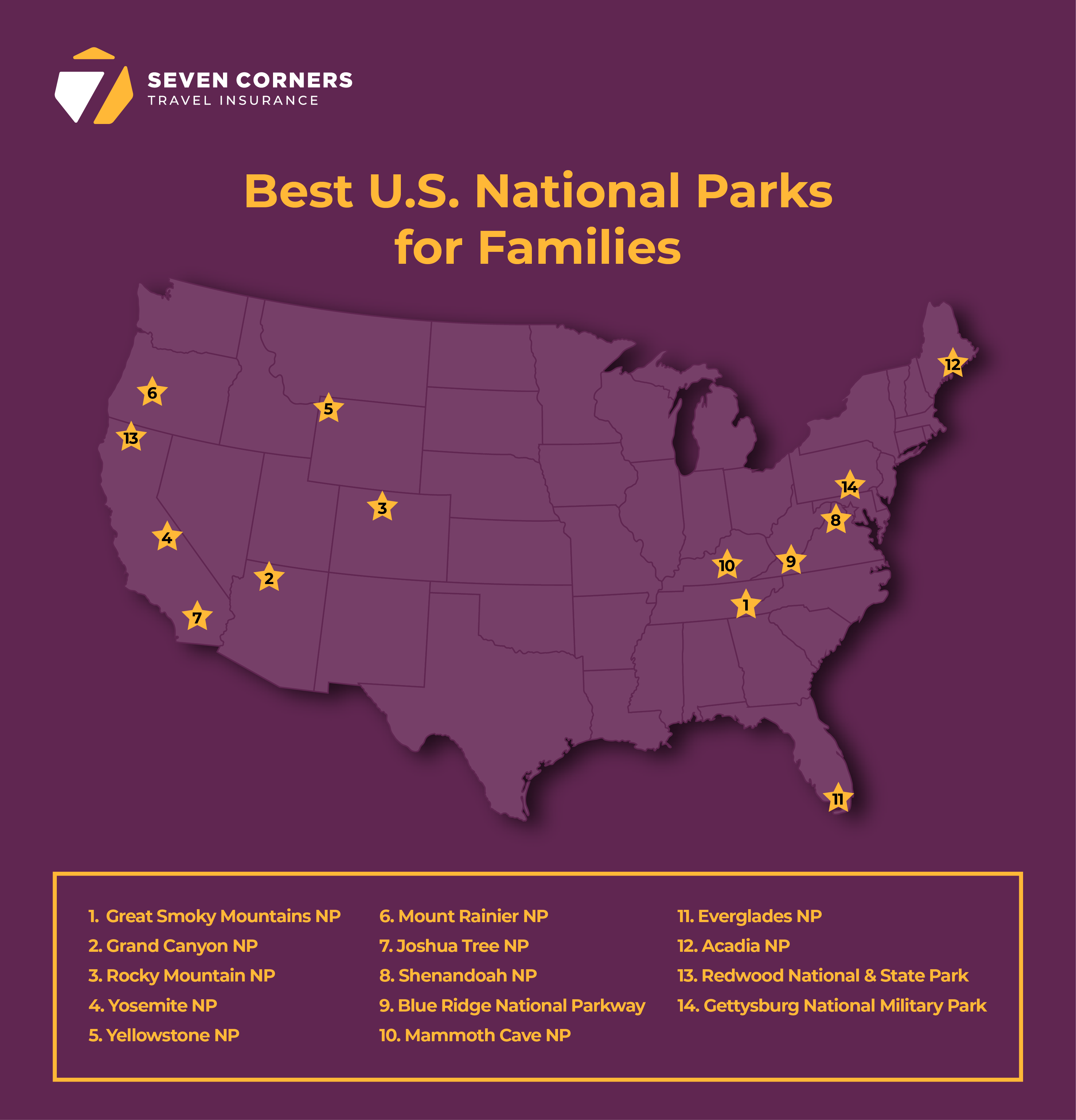 Best National Parks for Kids
Best National Parks for Kids
1. Joshua Tree National Park
Of all the places on our list of best national parks for kids, Joshua Tree National Park is probably the least crowded. That’s not an insult to Joshua Tree; the others are just that special.
“Those other parks have a wide variety of interesting things for all the different members of the family. They’re also the most crowded, probably for that reason,” said Martha Hart, who has visited 39 of our 63 national parks as well as, she so humbly mentioned, 22 national monuments, 51 historic sites, and 22 battlefields. And many of those trips involved lugging her kids alongside her. (Full disclosure: I’m one of those kids. She’s also my mom.)
But back to the parks. The exception to all the crowds is Joshua Tree, “which is just neat.”
Part of what makes this park so “neat” are the eponymous trees that look like something that escaped from a Dr. Seuss book. Native only to this part of the American Southwest, the Joshua tree looks a bit like someone crossed a palm tree with a yucca plant.
You’ll also see plenty of teddy bear cacti, especially along the Cholla Cactus Garden Trail. This trail, at just a quarter of a mile long, is often picked as one of the best trails in Joshua Tree for kids. Beware the Cholla cactus, though. Despite the cuddly teddy bear nickname, you don’t want to touch them.
“You will be picking cholla cactus off your kids if you get out of the car,” said Martha. “Probably off your clothes, too. They love to take a ride to spread their seeds!”
Alternatively, you can stick to the Discovery Trail, noteworthy because it was designed by local school children, or explore the huge rock formations throughout the park.
Location also plays a part in why Joshua Tree isn’t as frequently visited as some of the other parks. Located in Southern California, it’s about two-and-a-half hours east of Los Angeles, three hours west of Phoenix, and four hours south of Las Vegas by car, making it one of the more remote stops on our list.
2. Great Smoky Mountains National Park
 On the other end of the spectrum, Great Smoky Mountains National Park sees more visitors than any other national park. This is a testament to its beauty as well as ease of access. The park, which straddles the border of Tennessee and North Carolina, is within easy driving distance of several cities, making it a simple road trip with kids, especially if you live in the eastern United States.
On the other end of the spectrum, Great Smoky Mountains National Park sees more visitors than any other national park. This is a testament to its beauty as well as ease of access. The park, which straddles the border of Tennessee and North Carolina, is within easy driving distance of several cities, making it a simple road trip with kids, especially if you live in the eastern United States.
This park has a special place in my heart. My family went tent camping in the Smoky Mountains every spring break when I was a kid. In addition to days of hiking and hanging out at the campground, we also made day trips to Gatlinburg (my choice) and Pigeon Forge (my sister’s) for a good meal we didn’t have to cook over the campsite fire and some souvenir shopping.
The Smoky Mountains are a great pick for any family with a budding naturalist or wildlife lover. Scientists have documented some 17,000 species of animals and plants but estimate there’s upwards of 80,000 different kinds of plants and wildlife within the park’s borders.
You can try to catch a glimpse of them on any number of the park’s 800 miles of trails. Many of these trails are great for kids, with some of them measuring a mile or less. Check out the options for fishing, horseback riding, and bicycling while you’re there, too.
Technically, there is no entrance fee for Great Smoky Mountains NP, but you do need to purchase a parking tag. These are reasonably priced, though, at $5 per day or $15 for the week (as of March 2023).
3. Rocky Mountain National Park
At Rocky Mountain National Park, you’ll likely climb to some of the highest points in the United States. Or not, depending on the age and hiking skill of your kiddos. There are nearly limitless opportunities to hike here, and many of their trails are short loops of less than a mile. The fact that you’ll still see stunning scenery, waterfalls, lakes, and more is what makes Rocky Mountain National Park so family friendly.
The Junior Ranger program at RMNP is geared toward kids from age five to about 12, and the tasks they have to check off in their activity book are tailored by age. So no matter how old your future ranger is, they’re sure to learn about the best parts of the park at a level that’s right for them.
When everyone’s feet are ready for a break, drive the Trail Ridge Road. This 50-mile route is one of the most scenic is the U.S., and while you can see it all in a few hours, give yourself more time to make stops and explore a bit along the way.
Because Rocky Mountain National Park is one of the most visited — it's only about a 90-minute drive from Denver, Colorado — you may need to make a timed entry reservation. This depends on the time of year, so be sure to check the park’s website for requirements before you head out.
4. Grand Canyon National Park
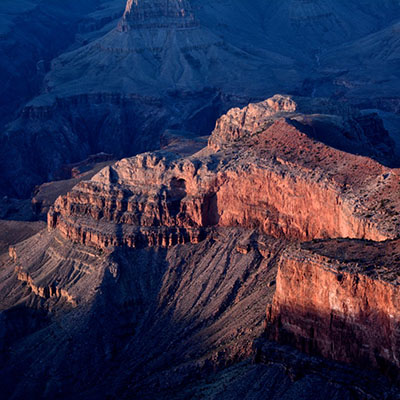 If you and the kids are natural history nuts, Grand Canyon National Park is for you. It’s an amateur archeologist’s dream. The oldest human artifacts found are nearly 12,000 years old and date to the Paleo-Indian period. As you descend into the canyon, chiseled over millions of year by the Colorado River — in the state of Arizona — your hike is a walk through history.
If you and the kids are natural history nuts, Grand Canyon National Park is for you. It’s an amateur archeologist’s dream. The oldest human artifacts found are nearly 12,000 years old and date to the Paleo-Indian period. As you descend into the canyon, chiseled over millions of year by the Colorado River — in the state of Arizona — your hike is a walk through history.
If you don’t have a future historian on your hands, no worries. Like any park, there’s hiking for days. When choosing your route, pay attention to the trail grade, not just the distance. Even hikes that are shorter may be tough for small children. It’s a canyon, after all. Once you hike down, you’ll have to come back up.
Bike rentals are available if you’d rather see the Grand Canyon on two wheels, and some paved trails are closed to vehicle traffic. There are also plenty of driving and shuttle routes. These are perfect when you need a break from walking or if it’s extremely hot, like in the middle of the summer.
5. Yellowstone National Park
What makes Yellowstone National Park a natural treasure unique from all others? Geysers! There are more here than anywhere else on the planet. And protecting these was the main reason the land was preserved in 1872.
Old Faithful gets all the attention, and you can’t go to Yellowstone without experiencing this iconic moment. But that’s not the only super-heated site worth a visit. This park, located mostly in Wyoming, is situated on a volcanic hotspot, after all.
Take a walk on the boardwalks to see hot springs and bubbling mud pits. These can sometimes attract wildlife like bison, particularly in cooler weather. (For your safety and that of the animals, don’t touch or feed them.)
Yellowstone has its share of wide-open space. Take the kids on a horseback riding tour or sign up for an Old West-style cowboy cookout.
Your kids might also like to earn their Young Scientist patch. Pick up the booklet at the Canyon Visitor Education Center or Old Faithful Visitor Education Center and help them solve science mysteries around the park.
6. Yosemite National Park
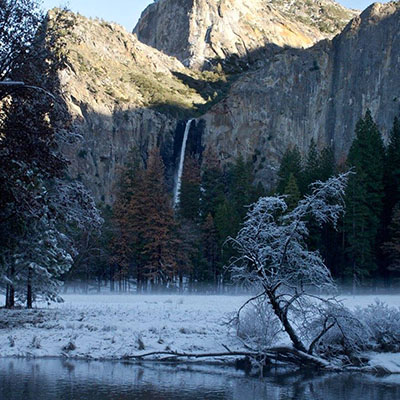 The majestic lands of Yosemite National Park inspired some of Ansel Adams’ most iconic photographs. Perhaps your child is the next artistic genius to be moved by this California gem.
The majestic lands of Yosemite National Park inspired some of Ansel Adams’ most iconic photographs. Perhaps your child is the next artistic genius to be moved by this California gem.
As with all national parks, camping is common, but a backdrop of granite cliffs, glaciers, and grand meadows sets it above all the rest. Plus, just imagine summer afternoon lunches shaded by a sequoia canopy. With 1,200 square miles of park land, you’ll wear holes in your boots from hiking.
Be sure to check out the Happy Isles Art and Nature Center, a family-friendly space with natural history exhibits, interactive displays, and art workshops. It’s also the starting point for several short trails, perfect for young hikers.
Bicycling is popular in the park, and many visitors find this to be the preferred way to get around during the busy season when car traffic backs up. Bike rentals are available in Yosemite Valley, and there are paved paths in some locations.
Lastly, if you’re kiddos love animals, carve out some time around dusk and keep your eye on the meadows. You never know what wildlife will wander by looking for an evening snack.
7. Mount Rainier National Park
My sister started her career as a park ranger at Mount Rainier National Park, so I’ve visited the park a few times (and gotten to go behind the scenes in some areas). It’s about two hours south of Seattle, making it one of the easier parks in the country to get to. That also means you could do a day trip to Mount Rainier if you’re short on time, but I guarantee you’ll wish you’d stayed longer.
Although the temperatures in the Pacific Northwest are rarely too extreme, it’s best to visit Mount Rainier in warmer months. This is because the elevation — and the snow that comes with it — can make it difficult or even impossible to reach some locations in the winter. On the other hand, there are ranger-led snowshoe hikes as well as sledding in the winter, both of which are great for kids.
In the spring and summer, be sure to stop at Paradise Visitor Center to start your booklet to become a Junior Ranger. This is also a good place to launch some easier hikes, like the Nisqually Vista Loop. You won’t want to miss the Grove of the Patriarchs trail, either.
Longmire visitor area is open year-round and houses a museum and the National Park Inn while offering clear views of Mount Rainier itself.
Best National Parks for Seniors
1. Shenandoah National Park
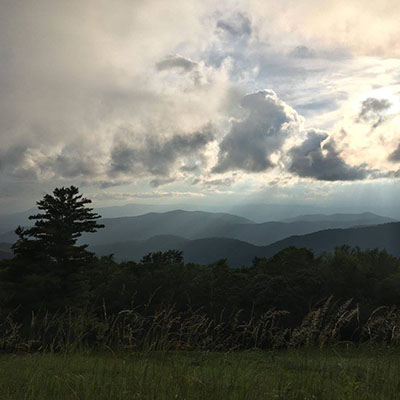 Parks in the Western United States might get most of the glory, but go east to Virginia and you’re bound to hear about the beauty of Shenandoah National Park. Less than two hours’ drive from Washington, D.C., this park is best known for the Skyline Drive, 105 miles of scenic byway running north to south.
Parks in the Western United States might get most of the glory, but go east to Virginia and you’re bound to hear about the beauty of Shenandoah National Park. Less than two hours’ drive from Washington, D.C., this park is best known for the Skyline Drive, 105 miles of scenic byway running north to south.
Skyline Drive is what draws many of the park’s visitors, especially in the fall when you can experience leaf peeping to the extreme. But if you’re there in the spring, you’ll enjoy fields full of flowers and, with a little exploring on foot, waterfalls. Shenandoah features more than 300 trails, some of which are part of the famous Appalachian Trail. Only one of these trails is wheelchair-accessible, though.
There’s an entrance fee of $30 per car for this park. However, admission to Shenandoah National Park is included in the National Park Service’s senior passes. (And since a Senior Annual Pass is just $20, you’ll come out ahead, even if this is the only park you visit all year.)
2. Blue Ridge National Parkway
It’s a national park, but it also has been designated as an All-American Road. Connecting Shenandoah National Park and the Smoky Mountains, the Blue Ridge Parkway is nearly 500 miles of gorgeous driving.
This route is perfect for travelers looking to take in natural beauty from the comfort of their own vehicle, looking for a bit of a relaxing adventure in between more active days, or those who enjoy some classic leaf peeping; the Blue Ridge Parkway is beautiful any time of year but really outdoes itself in the fall.
When you’re ready to stretch your legs, stop at the scenic overlooks or meander along some of the accessible trails.
3. Mammoth Cave National Park
For seniors and other individuals with mobility challenges, you might be questioning our suggestion of going down into a cave. But Mammoth Cave National Park in Kentucky has been improving in the area of accessibility.
You can take an elevator down to explore parts of the longest cave system in the world. Once you’re there, you’ll also find access for wheelchairs, canes, and other mobility devices. One tour also offers an audio guide for visitors with vision impairments.
If that still doesn’t sound fun, there is plenty to do above ground, including shorter, easier walks that can give you a cave-like experience.
4. Everglades National Park
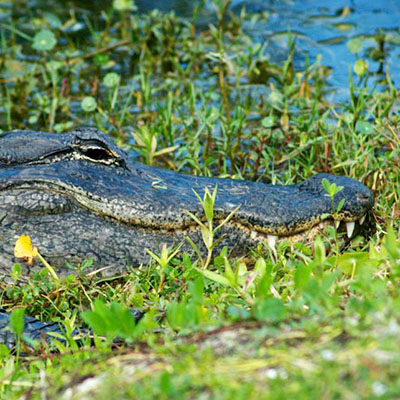 Keep heading south until you almost run out of land, and you’ll eventually bump into Everglades National Park in the southern tip of Florida. The subtropical wetlands are home to a great variety of wildlife. It’s the chance to see crocodiles, alligators, manatees, and other animals in the wild that draws many people to the Everglades every year.
Keep heading south until you almost run out of land, and you’ll eventually bump into Everglades National Park in the southern tip of Florida. The subtropical wetlands are home to a great variety of wildlife. It’s the chance to see crocodiles, alligators, manatees, and other animals in the wild that draws many people to the Everglades every year.
You don’t have to work too hard to catch a glimpse, either. “Everglades has trams, and you see TONS of cool animals from the tram,” says Martha. Even with the “gators” — my family has a healthy fear of these prehistoric-looking beasts — you'll still have the chance to get out on your own two feet and look around. There are plenty of hiking paths and boardwalks to explore safely.
There are seven wheelchair-accessible trails for those who need them (or for those who just prefer a flat, paved trail), as well as tactile exhibits and audio guides for those with vision impairments. Assistive listening devices are also available for ranger-led programs.
Admission is $30 per vehicle, $15 per person if you’re walking or cycling in, or free for visitors 15 and younger, making this a fairly economical stop if you’re on a multigenerational vacation.
5. Acadia National Park
Located in the U.S. state of Maine, Acadia National Park features rocky coastline, mountains, lakes, islands, plant and animal diversity, and cultural history, all wrapped into one neat — yet wild — package. Being so rocky and mountainous, the terrain can be difficult. However, if you’re concerned about mobility, you still have options.
The Park Loop Road is a 27-mile scenic drive on Mount Desert Island that features some of the park’s most popular attractions. Or take the Island Explorer bus, which can take you around the park and to some of the surrounding areas. Try the carriage roads, too, which are flat paths ideal for biking and walking without having to contend with motorized vehicles.
Acadia is about three-and-a-half hours’ drive from Portland, Maine, and five hours from Boston, so it’s a bit of a trek compared to some of the other parks on this list. The pay-off is well worth the effort, though, for such a stunning taste of the natural Northeast.
6. Redwood National and State Parks
If you subscribe to the mantra that the journey is as important as the destination, then you’re in for a treat with Redwood National and State Parks in northern California. This cluster of parks sits midway between Portland, Oregon, and San Francisco, and can be reached by traveling U.S. Highway 101, also known as the Pacific Coast Highway.
Amazing scenery gives way to some of the largest trees in the world inside the park. You can explore them by walking any of the 200 miles of trails; six of those trails are ADA-accessible. Some of the cabins are also ADA-accessible as are the campsites, if you decide to stay in the park for a few days.
When we asked Martha which park she thought was better for senior travelers — Redwood or Congaree National Park in South Carolina — she was all about the big trees. “I liked Congaree, but it can be very hot and buggy, and you need to walk to see it,” she said, referencing Congaree’s reputation for being overrun by mosquitos. “The temperatures are better in Redwood, and it is amazing from the car and with very short, easy walks.”
Temperatures in Redwood range from the 40s to upper 60s, depending on the season. So while it can be rainy up there near the Oregon border, the temperatures are rarely extreme in either direction.
7. Gettysburg National Military Park
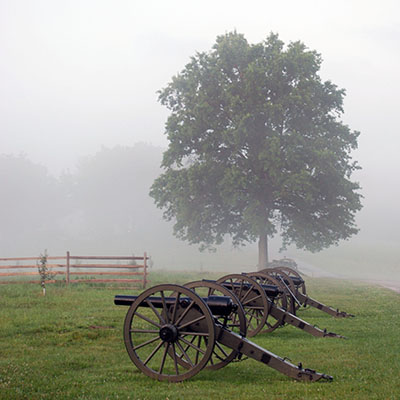 As a military park rather than a national park, you’ll spend most of your time exploring battlefields instead of nature's gems. If you’re a history buff, though, Gettysburg can’t be beat. “More history per square inch than you can absorb, and all from your car if you want,” said Martha.
As a military park rather than a national park, you’ll spend most of your time exploring battlefields instead of nature's gems. If you’re a history buff, though, Gettysburg can’t be beat. “More history per square inch than you can absorb, and all from your car if you want,” said Martha.
Start your trip at the visitor center and museum, even if you’re already well-versed in the U.S. Civil War. It’s large and detailed enough, even experts will find something to hold their interest. Then, head out to the park itself. There are a number of walking tours tailored to a range of ages and activity levels.
p>Alternatively, a self-guided driving tour gives you an overview of the battle from the comfort of your own car. Give yourself at least two hours to follow the full route, as it takes you to all the most important sites.
Yet a third option is to take a tour. The park even offers private tours where a licensed battlefield guide — their licensing test lasts several days — rides in your car with you. My parents did this (pre-COVID) and talked about it for years after. Even my history-teacher dad couldn’t out-nerd the guide, and they loved it.
The park itself is free to visit, but if you want to see the museum, film, and cyclorama, there is a fee. Seniors do get a modest discount.
Staying Healthy & Protected During a National Park Vacation
Did you know that a trip to the great outdoors, doing things together, can improve family dynamics? That means that in addition to the many physical and mental health benefits of time “in the wild,” you’re also building relationship health.
When you plan your vacation, visiting a national park may be just what the doctor ordered. Just don’t forget to hit the road without some protection. Trip insurance will keep you and your family safe so you can focus on letting the good times roll.
Learn more about Seven Corners travel insurance, including Seven Corners Trip Protection USA, a plan specifically designed for U.S. residents traveling within the United States. Our Trip Protection USA plan allows you to customize your coverage to your trip and gives you the flexibility to choose the protection you need.
Talk with travel insurance agent to learn more or get a quick, hassle-free quote online now.
Important Information from the United States Fire Insurance Company
AH-4025
Search Posts
Receive our monthly inspiration and travel tips from the travel insurance experts.
Sign me upThis website and various social media updates provided by Seven Corners contain content, information, articles, videos, and links to websites created by third parties. Seven Corners, its owners, and its employees neither endorse nor are responsible for the accuracy, timeliness, or reliability of any third-party information, statements, opinions, or advice and are not liable for any loss, harm, or damage caused by your reliance upon them. Use of such information or the linked websites is entirely at your risk. Concerns regarding this third-party content should be directed to the third party. Seek professional advice, as appropriate, regarding your use of such information and websites.
Because the information on this website and in Seven Corners’ blogs and other social media is written and compiled using knowledge and information available at a certain point in time, it may become outdated. For that reason, information, events, legal requirements, and product changes (including benefits, limitations, exclusions, and services) may not be up-to-date, complete, or accurate at the point in time it is being read. Again, use of such information is at your risk.
